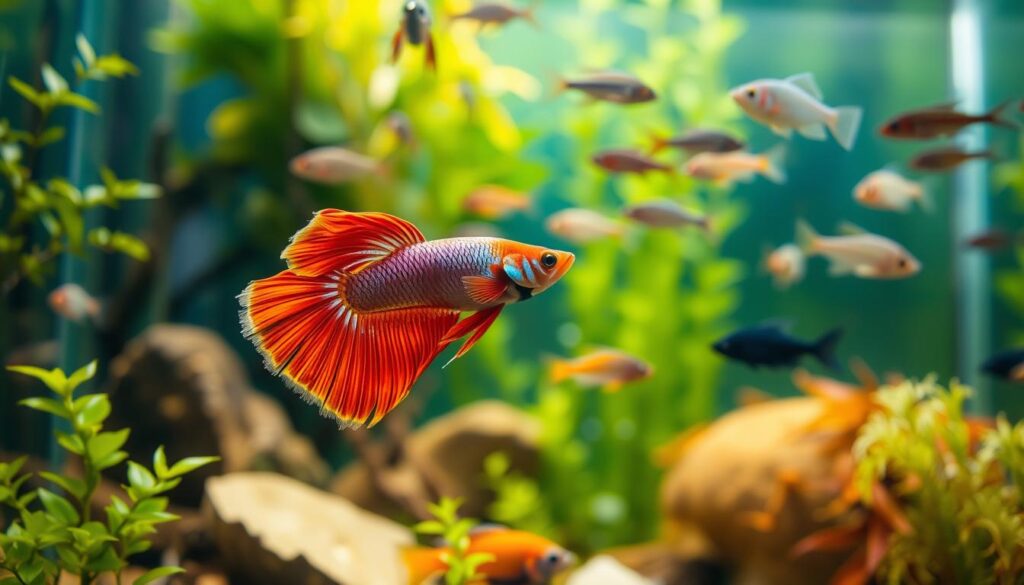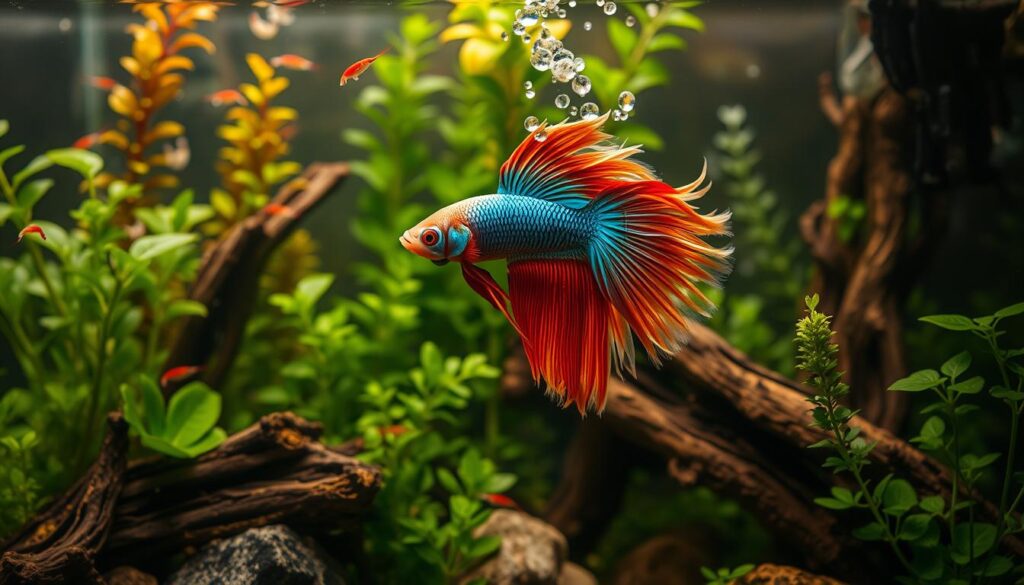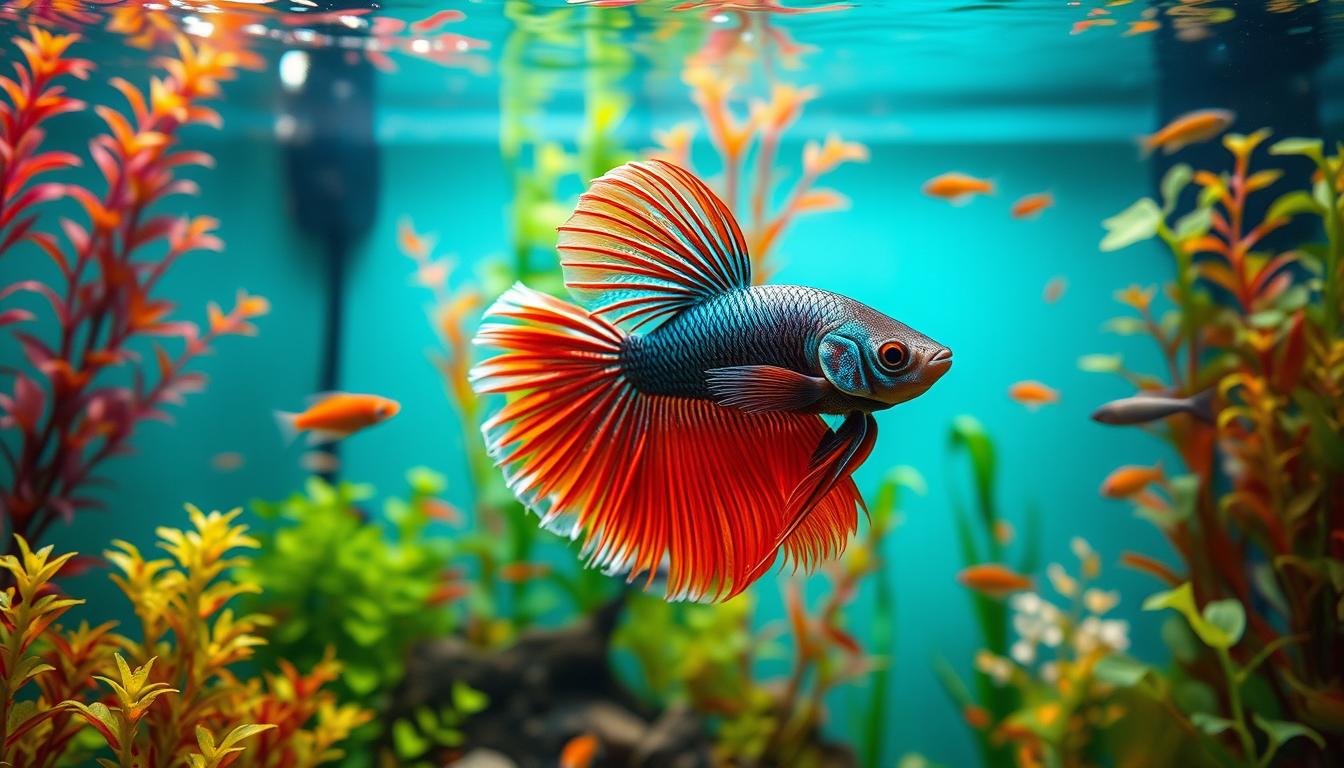Adding a female betta fish in community tank settings can be a beautiful and rewarding experience—if done right. Unlike their more aggressive male counterparts, female bettas are often more social and can coexist with peaceful tank mates in a well-planned aquarium.
But that doesn’t mean you can throw them in with any fish and hope for the best. From choosing the right tank size and companions to monitoring behavior, there’s a lot to consider. In this guide, we’ll explore everything you need to know about keeping a female betta fish in community tank setups safely and successfully.
Key Takeaways
- Understand the natural habitat of betta fish
- Learn how to create a harmonious community tank
- Discover the benefits and challenges of keeping betta fish with other species
- Get tips on betta fish compatibility and care
- Create a thriving environment for your betta fish
Understanding Female Betta Fish Behavior and Temperament
Let’s explore the world of female betta fish. We’ll look at their behavior and how they live together. Knowing how they act naturally helps make a peaceful community tank.
Natural Behavior in the Wild
Female betta fish come from shallow waters in Thailand. They show complex behaviors like defending their territory and socializing. By learning these behaviors, you can create a similar environment in your tank.
Read Also Why a Betta Fish Divided Tank Can Work Wonders for Your Aquarium
Differences Between Male and Female Bettas
Male betta fish are very aggressive. But, female betta fish are less aggressive but still have a pecking order. This is important when setting up a community tank, as it affects how they get along with other fish.
Social Hierarchy Among Female Bettas
Female betta fish have a social hierarchy, with a top female leading. This hierarchy can influence their behavior in a community tank. It’s key to watch how they interact with each other.
| Behavioral Trait | Male Betta Fish | Female Betta Fish |
|---|---|---|
| Aggression Level | High | Moderate |
| Social Structure | Solitary | Hierarchical |
| Territorial Behavior | Strong | Present |
Understanding these behaviors helps create a peaceful community tank. It ensures your female betta fish and their tankmates are happy and healthy.
Benefits of Keeping Female Betta Fish in Community Tanks
Keeping female Betta fish in a community tank is a great idea. They can live well with other fish. This setup lets you see how different fish interact, making it fun to watch.
Social Interaction Opportunities
Female Betta fish love to be around other fish. In a community tank, they can play, explore, and even make friends. This social life is good for their health and happiness.
Visual Appeal of Mixed Species Tanks
A community tank is a feast for the eyes. With different fish, it’s colorful and lively. It’s like a mini-nature show in your home.
Behavioral Enrichment for Bettas
Community tanks are great for keeping Bettas active. New fish and friends keep them busy. It’s good for their minds and bodies.
| Benefits | Description |
|---|---|
| Social Interaction | Female Betta fish can interact with other peaceful species, reducing stress and promoting well-being. |
| Visual Appeal | A community tank can be a stunning visual display, with different species adding variety in color, texture, and movement. |
| Behavioral Enrichment | Introducing new species and tankmates can encourage Betta fish to explore, hunt, and interact in new ways. |
Selecting the Right Tank Size and Equipment
Let’s explore the key steps to setting up a betta sorority tank. This setup is crucial for keeping your fish healthy and happy. It’s important to get the basics right for a community tank with female betta fish.
Minimum Tank Size Requirements
A 20-gallon tank is the minimum recommended for a betta sorority. This size offers plenty of space for swimming and establishing territories. You might ask, why so big? A larger tank reduces aggression and lets your betta fish thrive!
Essential Filtration Systems
Good filtration is key for clean, healthy water. For a betta community tank, a hang-on-back filter or canister filter is best. These systems keep water parameters stable, ensuring your fish stay healthy.
Heating and Temperature Control
Betta fish prefer warmer waters. A reliable aquarium heater keeps the temperature between 76-82°F (24-28°C). This is perfect for your betta’s comfort. Stable temperatures prevent stress!
Appropriate Lighting Considerations
Lighting greatly affects your tank’s ambiance. For a betta sorority, choose subdued lighting that matches their natural habitat. LED lights with adjustable brightness are great for creating a comfortable space for your female betta fish.
Creating the Ideal Habitat for Female Betta Fish in Community Tank
Creating a great home for female betta fish in a community tank needs careful planning. A well-thought-out tank reduces stress and keeps your fish healthy and happy.
Strategic Aquascaping with Plants and Decorations
Good aquascaping is key to a peaceful environment. Adding plants and decorations helps set up territories and hiding spots. This lowers aggression and stress among the fish. Plants like Java Moss or Anubias are great because they’re easy to care for and offer good cover.

Establishing Territories and Hiding Spots
Female betta fish like their own space. Setting up clear territories helps prevent fights. Decorations and plants create separate areas, giving each fish its own spot.
Best Substrate Options for Betta Communities
Picking the right substrate is important for water quality and fish health. Stay away from gravel or coarse substrates that can hurt your fish. Choose soft, fine-grained substrates like sand or eco-friendly options instead.
Optimal Water Parameters and Maintenance
Keeping water parameters in check is essential for your betta fish’s health. Regular water changes (about 25% every week) keep the water clean. Check pH, ammonia, nitrite, and nitrate levels to keep them safe. A well-kept tank is crucial for a happy community.
| Water Parameter | Ideal Range |
|---|---|
| pH | 6.5-7.5 |
| Ammonia | 0 ppm |
| Nitrite | 0 ppm |
| Nitrate | <20 ppm |
Best Tankmates for Female Betta Fish
Creating a thriving community tank starts with knowing which fish and invertebrates can live peacefully with female betta fish. It’s important to choose the right tankmates to ensure a harmonious environment.
Compatible Peaceful Fish Species
When picking fish for your tank, choose peaceful and non-threatening species. Some great options include:
- Tetras: These small, schooling fish are calm and add movement to the tank.
- Rasboras: Peaceful and easy to care for, rasboras come in various colors.
- Corydoras Catfish: These bottom-dwellers clean up food debris and are peaceful.
- Harlequin Rasboras: Bright colors and peaceful nature make them a great addition.
Suitable Invertebrates and Snails
Invertebrates and snails can also be good tankmates for female betta fish. Some good options include:
- Snails: Nerite or mystery snails clean algae and are ignored by bettas.
- Shrimp: Amano or ghost shrimp can live peacefully with female bettas if introduced correctly.
Species to Absolutely Avoid
While many tankmates are compatible with female betta fish, some should be avoided. These include:
- Fin-nippers: Fish like tiger barbs or serpae tetras that nip fins should be avoided.
- Aggressive fish: Fish that are naturally aggressive or territorial, like male bettas or cichlids, should not be housed with female bettas.
Proper Stocking Ratios and Tank Balance
Getting the right balance in your tank is key. Overstocking can cause stress and aggression, while understocking might lead to boredom or territorial behavior. Start with a small number of tankmates and adjust as needed.
By choosing compatible tankmates and maintaining a balanced ecosystem, you can create a vibrant and thriving community tank. This will showcase the beauty of your female betta fish.
Introducing Female Betta Fish to a Community Tank
Adding a female betta fish to a community tank is exciting. But, it needs careful planning and execution. You want a smooth transition for your new betta and the tank’s other fish.
Necessary Quarantine Procedures
Before adding your female betta to the community tank, quarantine is key. It stops diseases from spreading and lets you check your betta’s health. Use a separate tank with the same water conditions as the community tank for at least two weeks.

Proper Acclimation Methods
When your betta is healthy, it’s time to acclimate her to the community tank’s water. Start by floating the quarantine tank in the community tank for 15-20 minutes. Then, slowly mix community tank water into the quarantine tank. After 30 minutes, release your betta into the community tank.
Monitoring Initial Interactions
Watch the tank closely after introducing your betta. Look for aggression or stress signs like fin nipping, hiding, or chasing. If you see these, you might need to step in.
When and How to Intervene
If your betta is bullied or acts aggressively, you might need to separate her. Or, you could change the tank’s layout to give her more places to hide. Keep an eye on the tank’s fish and adjust as needed to keep peace.
By following these steps, you can introduce your female betta to a community tank successfully. Remember, patience and watching closely are crucial for a peaceful tank.
Managing Betta Fish Aggression in Community Settings
Keeping female betta fish in a community tank requires understanding and managing aggression. Female betta fish are less aggressive than males but can still show aggressive behavior.
Warning Signs of Aggression to Watch For
Look out for flared fins, aggressive posturing, and nipping at other fish. You might see your betta fish chasing others or showing dominance. “Aggression is a natural behavior in betta fish, but it can be managed with the right strategies,” says a renowned aquarist.
Effective Preventative Measures
Ensure your tank is at least 20 gallons and well-planted with hiding spots. Try rearranging decorations or adding plants to distract aggressive fish. Keeping water quality optimal and providing a balanced diet can also help reduce stress and aggression.
Dealing with Persistent Aggression
If aggression doesn’t stop, you might need to separate the aggressive fish or adjust tankmates. Watch your fish closely and be ready to intervene if needed. “A fish out of water is better than a fish that’s always stressed!” Keeping a close eye on your fish helps spot issues early.
When Separation Becomes Necessary
In some cases, separating aggressive fish is the only solution. This can be done by removing the aggressive fish to a separate tank or using dividers. While it may seem like a hassle, it’s often necessary to keep peace in the community tank.
Feeding Female Betta Fish in Community Tanks
Feeding female betta fish in a community tank is key. They are carnivorous and need a diet rich in protein.
Specific Nutritional Requirements
Female betta fish need a varied diet. This includes high-quality commercial betta pellets or flakes. Add live or frozen foods like brine shrimp or bloodworms. A balanced diet is vital for their health.
Effective Feeding Strategies in Mixed Species Tanks
To avoid competition, feed your betta fish at the surface. Use a feeding ring or a small, shallow dish. This makes it easier for your betta to eat without competition.

Preventing Food Competition
Feed your betta fish when the tank is quiet. Consider feeding them separately from other fish. You can remove the betta to a separate container or use an automatic feeder.
Recommended Supplemental Foods and Treats
Supplemental foods like daphnia, mosquito larvae, and finely chopped earthworms add variety. They ensure your betta gets a wide range of nutrients. Treats should be given sparingly to avoid overfeeding.
| Food Type | Nutritional Benefit | Feeding Frequency |
|---|---|---|
| Betta Pellets | High in protein, balanced nutrients | Daily |
| Brine Shrimp | Rich in protein, promotes growth | 2-3 times a week |
| Bloodworms | High in protein, nutrient-rich | 1-2 times a week |
Health Concerns and Disease Prevention for Female Bettas
Keeping your female Betta fish healthy is key. You need to watch their health closely and prevent diseases. When you have different fish together, diseases can spread easily. So, it’s important to stay alert about your fish’s health.
Common Diseases and Their Prevention
Female Bettas can get sick with fin rot and ich. Fin rot happens when the water is bad. Ich is a parasite that can come from dirty water or equipment. To stop these sicknesses, keep the water clean and quarantine new fish before adding them to your tank.
Recognizing Stress Indicators
Stress can make your Betta sick. Look for signs like being very tired, not eating, or breathing hard. If you see these signs, fix the problem. This could be changing the water or adding more places for your fish to hide.
Treatment Options in Community Settings
If your Betta gets sick, you must act fast. For fin rot, clean the water and use antibiotics. For ich, warm up the water and treat with a parasite medicine. But, be careful with medicines in a tank with other fish. They can harm them.
Effective Quarantine Protocols
Quarantining sick or new fish is crucial. Create a separate tank with the same water as your main tank. Carefully introduce your fish to this tank. Watch them for any sickness or stress. Treat them if needed before putting them back with the others.
Maintaining Water Quality in Female Betta Fish Community Tank
Keeping the water quality right is key for your female betta fish’s health in a community tank. Bad water quality can stress, make them sick, or even kill them!

Regular Water Parameter Testing
Testing the water regularly is your first defense against quality issues. Check pH, ammonia, nitrite, and nitrate levels weekly. This way, you can spot problems early and fix them before they get worse.
Read Also Betta Fish Stays at Top of Tank: What It Means and What to Do
Optimal Water Change Schedule
How often to change the water? For a tank with female betta fish, change about 25% every week. This keeps the water clean and stops toxins from building up.
Proper Filtration Maintenance
Your tank’s filter is its lifeblood, providing oxygen and removing waste. Clean it often and replace media as the maker suggests. This keeps it working well.
Balancing Bioload in Community Settings
Bioload is the waste your fish make. To keep things balanced, don’t overstock your tank. Make sure your filter can handle the waste. This keeps your tank clean and healthy for all your fish.
Troubleshooting Common Issues with Female Bettas in Community Tanks
Keeping a community tank with female betta fish can be tough. But, with the right steps, you can solve common problems. Female betta fish are lively and can make a community tank more interesting. Yet, issues like aggression, feeding problems, territory fights, and sickness can happen.
Addressing Unexpected Aggression
Aggression in female betta fish can be caused by many things. This includes the tank’s size, decorations, and tankmates. Make sure your tank is big enough (at least 20 gallons for a few fish) and has lots of hiding spots. If aggression doesn’t stop, try changing the tank’s layout or separating the aggressive fish.
Solving Feeding Challenges
Feeding issues can happen when female betta fish don’t want to eat or are outcompeted. To fix this, give them a varied diet with high-quality betta pellets and live or frozen foods. Feed them at the surface or mid-water to avoid competition from fish that live on the bottom.
Managing Territory Disputes
When female betta fish feel their space is being taken, they might fight. To handle this, set up different territories in the tank with plants, rocks, and decorations. Make sure each fish has enough space to claim its territory without stepping on others.
Dealing with Illness Outbreaks
Illness can spread quickly in a community tank. To fight this, keep the water clean with regular changes and watch your fish for signs of sickness. If a fish gets sick, isolate it right away to stop the disease from spreading.
Conclusion
You now know how to create a peaceful community tank with female betta fish. We’ve covered everything from their behavior to picking the right tankmates. You’re all set to start a thriving betta sorority.
Success comes from careful planning and paying attention to details. Choose the right tank size, equipment, and tankmates. This will help you create a beautiful display of female betta fish. Feel free to get creative with your decorations – your betta friends will love it!
Starting this aquatic journey means every tank is different. It might take some time to find the perfect balance. But with patience, persistence, and the right advice, you’ll soon have a peaceful and thriving tank. So, go ahead and start your adventure – your female betta fish are waiting!

